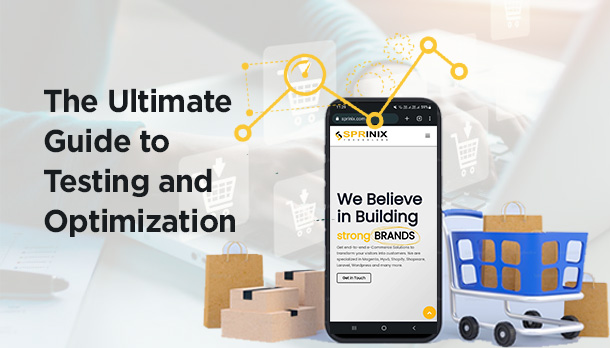The Ultimate Guide to Testing and Optimization
Welcome to the ultimate guide to testing and optimization for your e-commerce website! As we all know, e-commerce is the process of buying and selling products or services online. But what many don't know is the importance of testing and optimization for a successful online business.
Testing and optimization help you to identify areas that need improvement and determine what works best to achieve your business goals. With the fierce competition in the online marketplace, testing, and optimization have become the backbone of a successful e-commerce strategy.
So, whether you are a new e-commerce business or an established one, testing and optimization should be an ongoing process to continuously improve your website's performance. Let's dive in and learn more about how to do that effectively.
Identifying the areas for Optimization
As an e-commerce business owner, you want to ensure that your website is optimized for maximum results. To achieve this, analyzing user data is crucial. You can do this by leveraging web analytics tools like Google Analytics to understand your customer's demographics, interests, and behaviors. This data provides valuable insights into areas that require improvement.
Identifying key performance indicators (KPIs) is also critical. KPIs are metrics that help you measure the performance of your website against your business goals. Examples of KPIs that matter in e-commerce include conversion rate, bounce rate, average order value, and cart abandonment rate. By monitoring these KPIs and optimizing areas that affect them, you can boost your revenue and enhance your customers' experience.

But it's not enough to conduct these analyses once and forget about them. You need to continuously track your website's performance and optimize based on your findings. That's where testing and optimization come in. By creating a testing plan and implementing A/B and multivariate testing, you can isolate variables and determine which changes deliver the best results.
In summary, understanding your users and setting relevant KPIs are crucial in optimizing your e-commerce website. Continuously testing and iterating based on your findings is key to success. So, don't just sit there and hope for the best—constantly improve your website, and the sky's the limit!
Identifying the areas for Optimization
But it's not enough to conduct these analyses once and forget about them. You need to continuously track your website's performance and optimize based on your findings. That's where testing and optimization come in. By creating a testing plan and implementing A/B and multivariate testing, you can isolate variables and determine which changes deliver the best results.
So you've identified the areas for optimization in your e-commerce website. Now, it's time to create a testing plan. This plan should be your guiding force as you optimize your website for better results.
To start, let's talk about hypothesis generation. This involves creating assumptions about changes that you think will lead to better user experience and increased conversions. For example, you might hypothesize that changing the color of a CTA button will result in more clicks.
Next, you need to create variations. This involves making the changes you hypothesized about and creating different versions of your website to test which variation performs the best. Don't be afraid to get creative, after all, you won't know which variation is the best until you test them all.
But how will you measure success? That's where determining success metrics comes in. Success metrics are the key performance indicators you'll use to measure the effectiveness of each variation. Successful metrics should be specific, measurable, and tied to your business goals.
Creating a testing plan can seem overwhelming, but with the right approach, it doesn't have to be. By hypothesizing, creating variations, and determining success metrics, you'll have a clear path to continuous improvement for your e-commerce website.
A/B Testing
Let's get into the nitty-gritty of testing and optimizing your e-commerce website! A/B testing is an effective way of finding out what works and what doesn't. Start by designing and launching your tests, which can include anything from changing button colours to testing different headlines. It's important to keep in mind the specific elements of your website that you want to improve, and make sure that the changes you test are focused on those elements.
Once your tests are launched, it's time to analyze the results. Look for statistically significant differences between the control and the variation, and use that data to determine the winner. But here's the catch - don't just jump the gun and make changes straight away. Keep in mind the bigger picture of how all the elements of your website work together to create the best possible user experience.

A/B testing can be a powerful tool, but it can be easy to fall into the trap of testing too many things at once. Stick to testing a few big changes at a time, and always keep track of what you've tested in order to avoid confusion. With that said, always remember that testing is only one half of the equation - the other half is actually implementing the changes based on what you've learned from your testing. With a thoughtful approach, you can use A/B testing as an effective tool to continuously improve the performance of your e-commerce site.
Multivariate Testing
Now, for the advanced level optimization enthusiasts, let's dive into Multivariate testing. While A/B testing lets you test one variation against an original, multivariate testing lets you test multiple variations at once. Sounds like something only the nerds would do, right? Wrong! You'll be surprised at how much insight and improvement multivariate testing can bring to your e-commerce website.
Designing and launching multivariate tests might seem complicated, but it's all worth it. For starters, it helps in identifying the most impactful elements and combination of those elements on your website. It saves time, as instead of testing one element at a time, you can test multiple elements together, giving you more insights into the user behavior.
Analyzing the results can be tricky, but nothing a good cup of coffee can't fix. By analyzing the results, you can get a clear picture of what works and doesn't work. Keep in mind, though, to only test a few variations at a time, having too much data at once can be overwhelming. Stick to the important data which can give you valuable insight for optimum results.
Implementing the changes
Implementing the changes in your e-commerce website is the most crucial step in the testing and optimization process. After analyzing the data and testing the hypotheses, it's time to act on the insights gained from the testing phase.
Prioritizing changes is necessary to ensure that the most impactful optimizations are implemented first. Using heatmaps and user recordings can help identify the exact pain points of your website and provide a clear direction while making necessary design changes.
After implementing changes, it's crucial to continuously test and iterate to ensure that the website is yielding the desired results. This process of continuous improvement is vital to staying relevant in the ever-evolving online marketplace.
In conclusion, remember that optimization is a never-ending process. Keep testing, keep improving, and always stay up-to-date with the latest e-commerce trends and advancements.
Conclusion
After implementing the changes based on the testing and optimization results, the e-commerce website will start seeing improvements in user engagement, conversion rates, and ultimately revenue. Remember, testing and optimization are not a one-time task but a continuous process for continuous improvement. The importance of testing and optimization in e-commerce cannot be overstated, and it's up to the marketers to stay on top of it. Keep an eye on user behavior and continuously test and iterate for better results. Your website should always be improving, and testing and optimization are the key to making that happen.
Thanks for reading our article, please feel free to share your feedback, suggessions, and queries by adding a comment or write us at info@sprinix.com.








